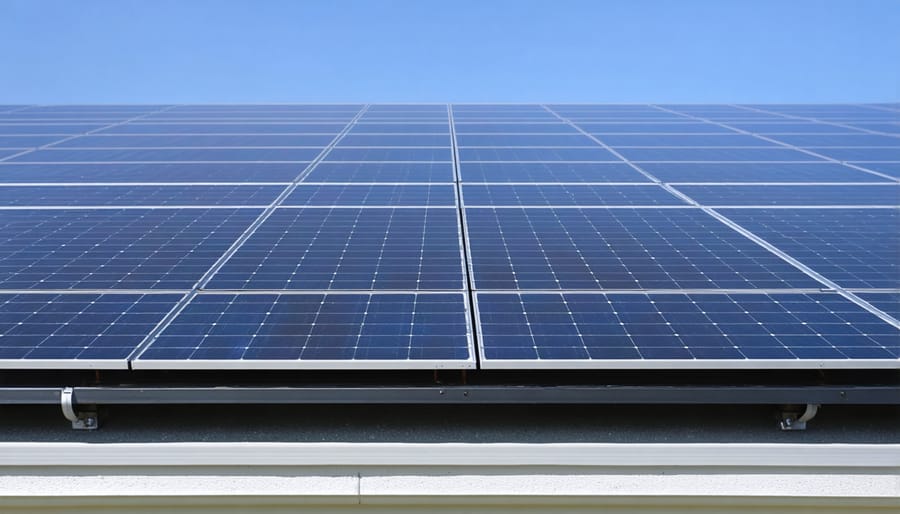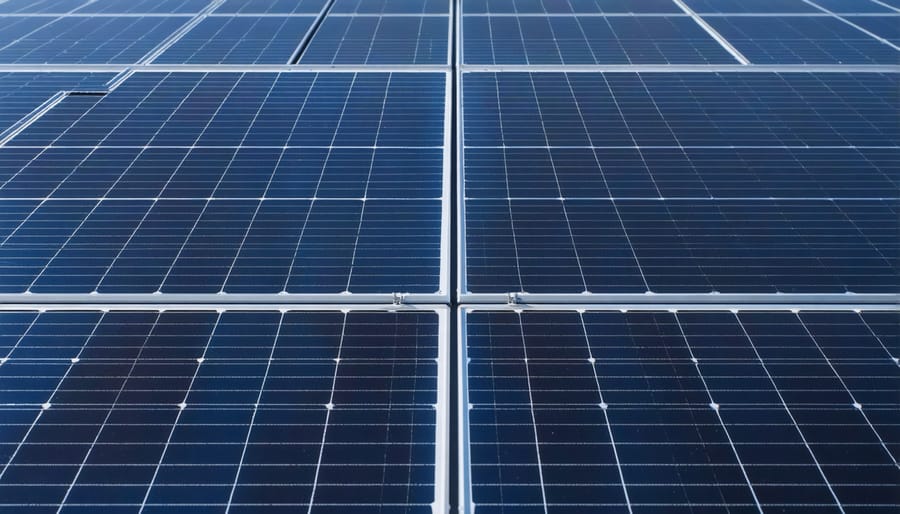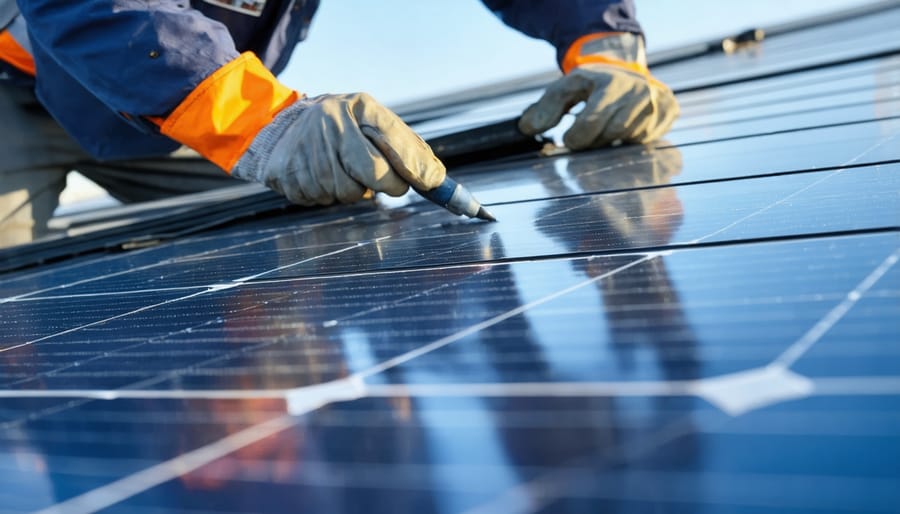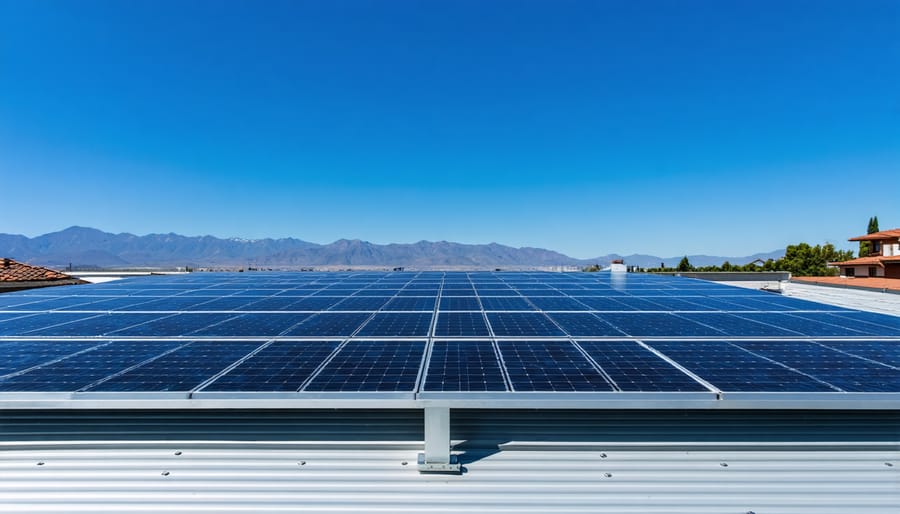Maximize your solar investment’s potential by understanding the performance ratio (PR) – the crucial metric that reveals how efficiently your solar system converts sunlight into usable electricity. This key indicator, typically ranging from 0.6 to 0.8 in British Columbia’s climate, compares your system’s actual energy output against its theoretical maximum capacity. For homeowners and businesses across BC, monitoring your PR provides vital insights into system health, maintenance needs, and opportunities for optimization. Whether you’re considering solar installation or already generating clean energy, mastering your system’s performance ratio helps ensure optimal returns on your renewable energy investment while contributing to our province’s sustainable future.
What Is Solar Performance Ratio?

The Performance Ratio Formula
The Performance Ratio (PR) formula is straightforward once you understand its components. To calculate solar panel efficiency, divide the actual energy output by the theoretical maximum output, then multiply by 100 to get a percentage.
PR = (Actual Energy Output ÷ Theoretical Maximum Output) × 100
For example, if your solar system in Vancouver generates 8,000 kWh annually when its theoretical maximum is 10,000 kWh, your performance ratio would be:
(8,000 ÷ 10,000) × 100 = 80%
Most well-designed solar systems in British Columbia achieve performance ratios between 75% and 85%. Local factors like shading from nearby trees, snow accumulation in winter months, and regular maintenance all impact this ratio. A system in Victoria might perform differently than one in Prince George due to varying weather patterns and solar irradiance levels.
To calculate your system’s theoretical maximum, multiply your installed capacity by the total hours of sunlight and the standard test condition efficiency rating of your panels.
Factors Affecting Performance Ratio
Environmental Factors
British Columbia’s unique climate and geography create distinct challenges and opportunities for solar energy systems. Coastal regions experience frequent overcast skies, while interior areas enjoy more sunny days but face temperature variations. Understanding how these environmental factors affect your system’s performance ratio is crucial for optimizing solar investment.
Temperature significantly impacts solar panel efficiency, with panels typically performing better in cooler conditions. BC’s moderate climate is actually advantageous, as excessive heat can reduce panel efficiency. However, snow accumulation in winter months requires consideration, though the reflective properties of snow can sometimes enhance performance during cloudy conditions.
Shading from nearby trees, buildings, or mountainous terrain can dramatically affect performance ratios. Even partial shade on one panel can reduce the efficiency of an entire string. Local weather patterns, particularly in coastal areas, mean systems must be designed to maximize production during clear periods while maintaining reasonable output during overcast conditions.
To optimize performance ratio, consider seasonal variations in sun angle, local microclimate conditions, and potential shading obstacles when planning your solar installation. Regular maintenance, including snow removal and panel cleaning, helps maintain optimal efficiency throughout the year.
System Design and Installation
The quality of your solar system’s design and installation plays a crucial role in achieving a high performance ratio. Key components like inverters, panels, and wiring must be carefully selected and properly integrated. Professional installers ensure optimal panel positioning and spacing, considering local factors like shade patterns and BC’s unique weather conditions.
Quality components from reputable manufacturers typically offer better efficiency and durability. For example, premium solar panels often have better temperature coefficients, which is particularly important for BC’s varying climate. Similarly, choosing the right inverter size and type can significantly impact system performance.
Installation quality matters just as much as component selection. Proper mounting, secure connections, and careful wire management prevent efficiency losses and potential safety issues. Regular inspection of these elements helps maintain high performance ratios throughout the system’s lifetime.
When planning your solar installation, work with certified professionals who understand local building codes and have experience with BC’s climate conditions. They can help design a system that maximizes efficiency while ensuring long-term reliability and safety.

Maintenance and Monitoring
Regular maintenance is crucial for keeping your solar system’s performance ratio at its peak. Monthly visual inspections can help identify issues like dirt buildup, fallen leaves, or snow accumulation that might reduce panel efficiency. In BC’s climate, scheduling professional cleanings twice a year – typically in spring and fall – ensures optimal sunlight absorption.
Monitoring your system’s output through its digital interface helps detect performance drops early. Many BC solar owners use smartphone apps to track daily generation patterns, making it easier to spot when maintenance is needed. Local solar companies often provide maintenance packages that include regular check-ups, cleaning services, and performance monitoring.
Simple tasks like trimming nearby trees and promptly removing debris can significantly impact your system’s performance ratio. Remember, a well-maintained solar system can maintain its optimal performance ratio for 20-25 years, maximizing your return on investment.
Improving Your Solar System’s Performance Ratio
Regular Performance Checks
To maintain optimal solar system performance, schedule regular performance checks every three to six months. Start by monitoring your daily energy production through your system’s monitoring app or interface. Keep an eye out for any significant drops in output that can’t be explained by seasonal changes or weather patterns.
Create a simple maintenance checklist that includes inspecting solar panels for dirt, debris, or shade from growing vegetation. In BC’s coastal areas, where rainfall is frequent, panels generally stay clean, but spring and fall inspections are still recommended. Document your system’s performance ratio readings to track trends and identify potential issues early.
Consider partnering with a local solar maintenance provider for annual professional inspections. They can perform detailed efficiency tests and catch problems that might not be visible to the untrained eye. Many BC solar installers offer maintenance packages that include regular performance checks and cleaning services.
Remember to compare your system’s actual performance against its expected output based on local solar irradiance data. This helps you understand if your system is operating at its full potential and when maintenance might be needed.

Professional Optimization Services
Several certified solar optimization services are available throughout British Columbia to help maximize your solar system’s performance ratio. Local companies like BC Solar Solutions and Green Energy Consultants offer comprehensive system assessments, using advanced monitoring tools to identify efficiency losses and improvement opportunities.
These professional services typically include detailed performance audits, thermal imaging inspections, and data analysis to pinpoint issues affecting your system’s output. Technicians can detect problems ranging from partial shading and dust accumulation to more complex electrical inefficiencies that might go unnoticed during routine maintenance.
Many providers also offer ongoing monitoring services, providing real-time performance tracking and quarterly optimization reports. This proactive approach helps maintain peak efficiency and extends system longevity. Some companies even provide performance guarantee programs, ensuring your system meets or exceeds expected output levels.
For those in remote BC communities, several providers now offer virtual consultations and remote monitoring solutions, making professional optimization services accessible throughout the province. Most services can be customized to suit both residential and commercial installations, with flexible pricing options based on system size and service level.
Understanding your solar performance ratio is crucial for maximizing your renewable energy investment in British Columbia. By monitoring this key metric, you can ensure your solar system operates at its peak efficiency and delivers the expected returns. Remember to regularly check your system’s performance, conduct seasonal maintenance, and work with qualified solar professionals for optimal results.
Take the next step by scheduling a performance assessment of your existing system or consulting with local solar experts about new installations. Consider joining BC’s growing solar community through workshops and online forums to share experiences and learn from others. With proper attention to your system’s performance ratio, you’ll contribute to our province’s clean energy future while enjoying reliable, sustainable power for years to come.
For personalized advice about improving your system’s efficiency, reach out to local solar providers or connect with BC’s sustainable energy organizations. Together, we can build a brighter, cleaner future for British Columbia.

